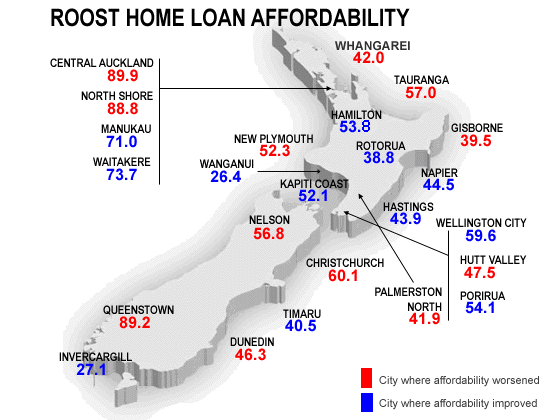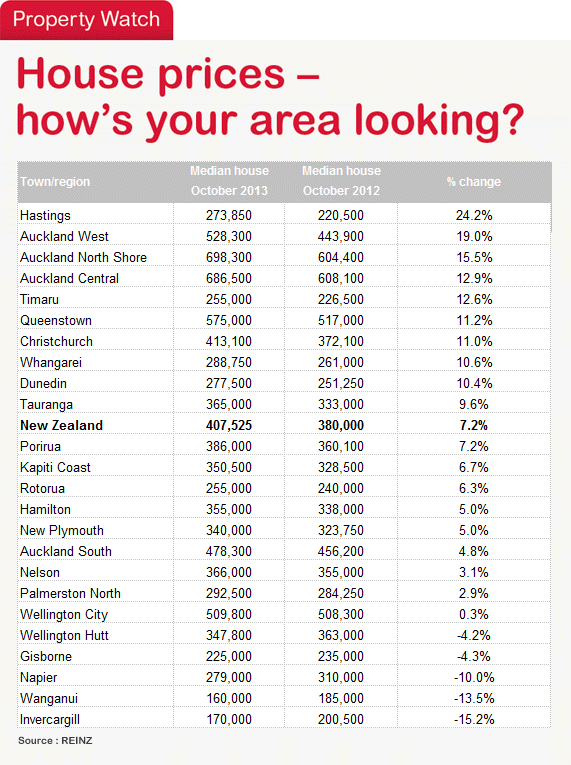
Home loan affordability worsened again across most of New Zealand in October as house prices continued rising despite the Reserve Bank imposing lending restrictions from October 1.
Surveys show a significant slowing of low deposit lending and first home buyer activity through October, but it has yet to flow through into a slowdown in house price inflation.
Median house prices rose in 19 out of 24 regions and hit record highs in Auckland, Hamilton and Canterbury.
The Roost Home Loan Affordability reports show affordability worsened in 12 out of 24 regions as small income increases in some areas only partially offset the effects of higher house prices.

The Reserve Bank has said it does not expect its limit on high Loan to Value Ratio mortgages to be seen immediately in housing market data. It expects to see evidence of an impact within three to six months.
Mortgage brokers report banks are being very cautious about lending to those with deposits of less than 20% of the value of the property being bought, given many banks want to be absolutely sure they are within the Reserve Bank rules, which limit high LVR loans to 10% of all new mortgages.
"The Reserve Bank's new policy has shaken up the bank's lending and marketing strategies," said Roost Mortgage Brokers spokeswoman Colleen Dennehy.
"Banks are being choosier about who gets a loan and what their interest rates will be, which means borrowers need all the help and advice they can get from a broker," she said.
The Roost Home Loan Affordability reports show national affordability worsened to 58.2% in October from 57.3% in September after the national median house price rose to NZ$407,525 from NZ$400,000 in September. The reports measure the percentage of after tax pay needed to service an 80% mortgage on a median priced house.
The Roost Home Loan Affordability report for October showed affordability for regular home buyers improved in Manukau, Waitakere, Wanganui, Wellington City, Timaru and Invercargill, while affordability worsened in Central Auckland, North Shore, Whangarei, Tauranga, Christchurch, Nelson and Dunedin.
It was toughest for first home buyers in Auckland. It took 101.7% of a single median after tax income to afford a first quartile priced house on the North Shore in October.
Average fixed mortgage rates, which more than 50% of new borrowers now use, fell slightly in October for those with more than 20% equity and after-tax wages rose just over NZ$2 per week to NZ$816 per week. Interest rates rose for those borrowing more than 80% of the value of the home.
Housing affordability has become a major economic and political issue over the last year. The Reserve Bank and Government agreed on a toolkit of 'macro-prudential' controls in May that would see the central bank impose limits growth in high loan to value ratio mortgages. Central and local governments are also moving to address housing supply shortages.
For first home buyers – which in this Roost index are defined as a 25-29 year old who buys a first quartile home – there was also a deterioration in affordability in most cities.
It took 47.7% of a single first home buyer's income to afford a first quartile priced house nationally, up from from 46.9% a month earlier. The most affordable city in
Any level over 40% is considered unaffordable, whereas any level closer to 30% has coincided with increased buyer demand in the past.
For working households, the situation is similar, although bringing two incomes to the job of paying for a mortgage makes life considerably easier. A household with two incomes would typically have had to use 38.3% of their after tax pay in October to service the mortgage on a median priced house. This is up from 37.6% in September.
On this basis, most smaller New Zealand cities have a household affordability index below 40% for couples in the 30-34 age group. This household is assumed to have one 5 year old child.
For households in the 25-29 age group (which are assumed to have no children), affordability nationally worsened to 23.6% of after tax income in households with two incomes required to service the debt, up from 23.1% the previous month.
Any level over 30% is considered unaffordable in the longer term for such a household, while any level closer to 20% is seen as attractive and coinciding with strong demand.
First home buyer household affordability is measured by calculating the proportion of after tax pay needed by two young median income earners to service an 80% home loan on a first quartile priced house.
---------------------------------------------------------------------------------------------------------------------------------------
Mortgage choices involve making a significant financial decision so it often pays to get professional advice. A Roost mortgage broker can be contacted by following this link »
---------------------------------------------------------------------------------------------------------------------------------------
No chart with that title exists.
Full regional reports are available below:
4 Comments
Bernard , I am told the LTVR calculation has to include all borrwings by the client ( ie car and vehicle finance , credit cards , etc) is that true ?
On the topic of borrowing , did you see the Reuters report that the UK is to cap payday lenders interest rates?
I wonder when or if NZ will follow suit .
Far to many poor families are borrowing small sums at usurous interest rates of between 20 and 30% PLUS admin fees and compulsory Insurance , and getting in over their heads .
We need a simple but stringent set of rules for lenders
- No unsecured cash loans of more than 24 months
- Admin costs to be fixed at $100 per new loan , and $50 per repeat loan
- Insurance is to be passed on at cost , not cost plus
- Interest Rates cannot be more than OCR x 500% ( 12.5%) Per annum
- Total cost of credit cannot exceed exceed the Principal sum borrowed/ lent
Just to be clear, unsecured personal loan lenders (eg Instant Finance, GE Money) have interest rates in the 25-40%pa range, but payday lenders have rates much more than that - 200-500%pa. Payday lending is of the type 'borrow $100 today, pay back $120 in two weeks'. Interest rates on a pa basis then are absolutely huge. If you loaned someone $100 to be paid back in two weeks at 12.5% pa. (as you suggest) you would be getting back $100.48. I have difficulty thinking anyone (you included) would think this is a viable lending model.
Unregulated loan sharks are in a different league altogether. Borrow $100 now, pay back $150 in two weeks. The actual interest rate is then off the charts. If the promised repayment is then not made, then the repayments required are higher still, and effective % pa are probably not calculable.
I suspect having a viable regulated (effectively) unsecured persoanl loan industry is probably the best way to limit payday lenders and loan sharks.
Only the law abiding obey the law. Drive them out and all you are left with is unregulated, illegal sharks and that is not good for anyone.
I understand very well the problems posed by rapidly rising house prices but it's very difficult to get upset about my own properties going up in value by 13% to 19% over the past year.
Herein lies the problem I suppose.
I caught a bit on Breakfast TV this morning on One. Interview of some representative from the building industry bemoaning the drop off in new builds. What caught my attention was his admission that some FHB with maybe a 25% deposit are now holding off, because you know, by the time the final bill comes in for their new build they might still exceed their LVR limit.
That was an excellent admission and warning to FHB in the new build market as to how your likely to get worked over by your friendly builder or building outfit once you've signed the contract and committed to your dream home.


We welcome your comments below. If you are not already registered, please register to comment
Remember we welcome robust, respectful and insightful debate. We don't welcome abusive or defamatory comments and will de-register those repeatedly making such comments. Our current comment policy is here.